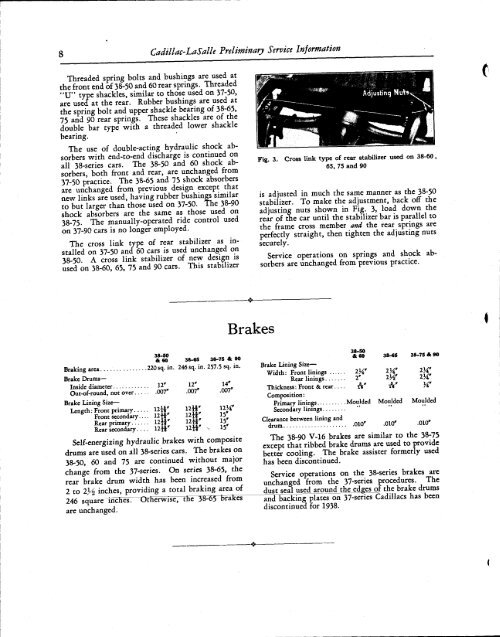1938 Cadillac V16 - GM Heritage Center
1938 Cadillac V16 - GM Heritage Center
1938 Cadillac V16 - GM Heritage Center
You also want an ePaper? Increase the reach of your titles
YUMPU automatically turns print PDFs into web optimized ePapers that Google loves.
8<br />
<strong>Cadillac</strong>-LaSaile Preliminary Service Information<br />
Threaded spring bolts and bushings are used at<br />
the front end of 38-50 and 60 rear springs. Threaded<br />
"U" type shackles, similar to those used on 37-50,<br />
are used at the rear. Rubber bushings are used at<br />
the spring bolt and upper shackle bearing of 38-65,<br />
75 and 90 rear springs. These shackles are of the<br />
double bar type with a threaded lower shackle<br />
bearing.<br />
The use of double-acting hydraulic shock absorbers<br />
with end-to-end discharge is continued on<br />
all 38-series cars. The 38-50 and 60 shock absorbers,<br />
both front and rear, are unchanged from<br />
37-50 practice. The 38-65 and 75 shock absorbers<br />
are unchanged from previous design except that<br />
new links are used, having rubber bushings similar<br />
to but larger than those used on 37-50. The 38-90<br />
shock absorbers are the same as those used on<br />
38-75- The manually-operated ride control used<br />
on 37-90 cars is no longer employed.<br />
The cross link type of rear stabilizer as installed<br />
on 37-50 and 60 cars is used unchanged on<br />
38-50. A cross link stabilizer of new design is<br />
used on 38-60, 65, 75 and 90 cars. This stabilizer<br />
Fig. 3. Cross link type of rear stabilizer used on 38-60,<br />
65, 75 and 90<br />
is adjusted in much the same manner as the 38-50<br />
stabilizer. To make the adjustment, back off the<br />
adjusting nuts shown in Fig. 3, load down the<br />
rear of the car until the stabilizer bar is parallel to<br />
the frame cross member and the rear springs are<br />
perfectly straight, then tighten the adjusting nuts<br />
securely.<br />
Service operations on springs and shock absorbers<br />
are unchanged from previous practice.<br />
Brakes<br />
Braking area<br />
38-50<br />
& 60<br />
220 sq. in.<br />
Brake Drums—<br />
Inside diameter 12"<br />
Out-of-round, not over 007"<br />
Brake Lining Size—<br />
Length: Front primary 12ii*<br />
Front secondary 12¾"<br />
Rear primary llW<br />
Rear secondary.. .. YlW<br />
38-65 38-75 & 90<br />
246 sq. in. 257.5 sq. in.<br />
12*<br />
.007"<br />
14"<br />
.007"<br />
12½"<br />
15"<br />
15"<br />
15"<br />
Self-energizing hydraulic brakes with composite<br />
drums are used on all 38-series cars. The brakes on<br />
38-50, 60 and 75 are continued without major<br />
change from the 37-series. On series 38-65, the<br />
rear brake drum width has been increased from<br />
2 to 2½ inches, providing a total braking area of<br />
246 square TncKes^ CMierws^TSe^j^-^S^iralces -<br />
are unchanged.<br />
38-50<br />
& 60 38-65 38-75 & 90<br />
Brake Lining Sire—<br />
Width: Front linings 2½" 2¼" 1¼'<br />
Rear linings 2" 2½' 2½"<br />
Thickness: Front & rear A" &" H."<br />
Composition:<br />
Primary linings Moulded Moulded Moulded<br />
Secondary linings<br />
Clearance between lining and<br />
drum 010" .010" .010"<br />
The 38-90 V-16 brakes are similar to the 38-75<br />
except that ribbed brake drums are used to provide<br />
better cooling. The brake assister formerly used<br />
has been discontinued.<br />
Service operations on the 38-series brakes are<br />
unchanged from the 37-series procedures. The<br />
dust seal used around the edges of the brake drums<br />
and backing plates on 37-series <strong>Cadillac</strong>s has been<br />
discontinued for <strong>1938</strong>.
















